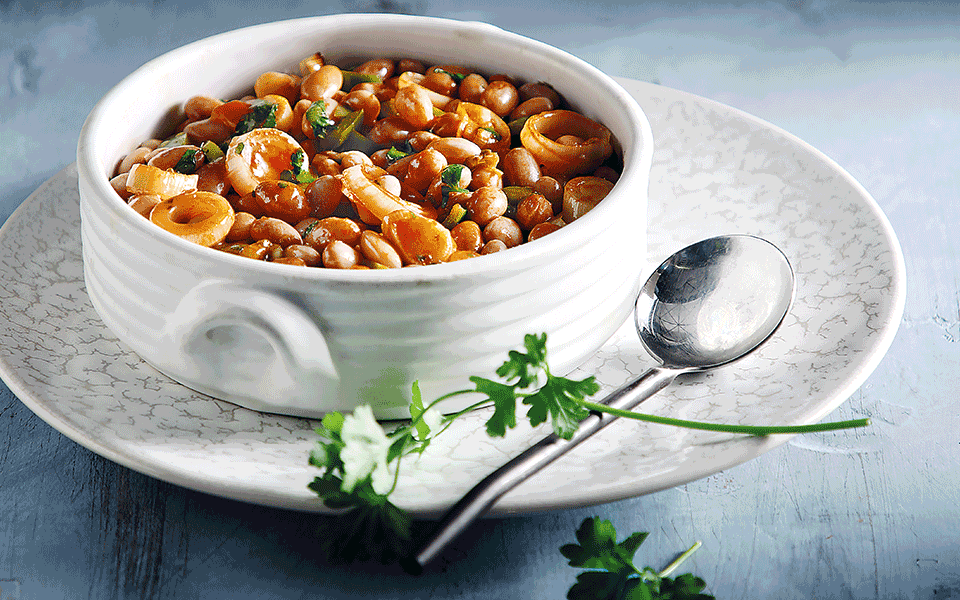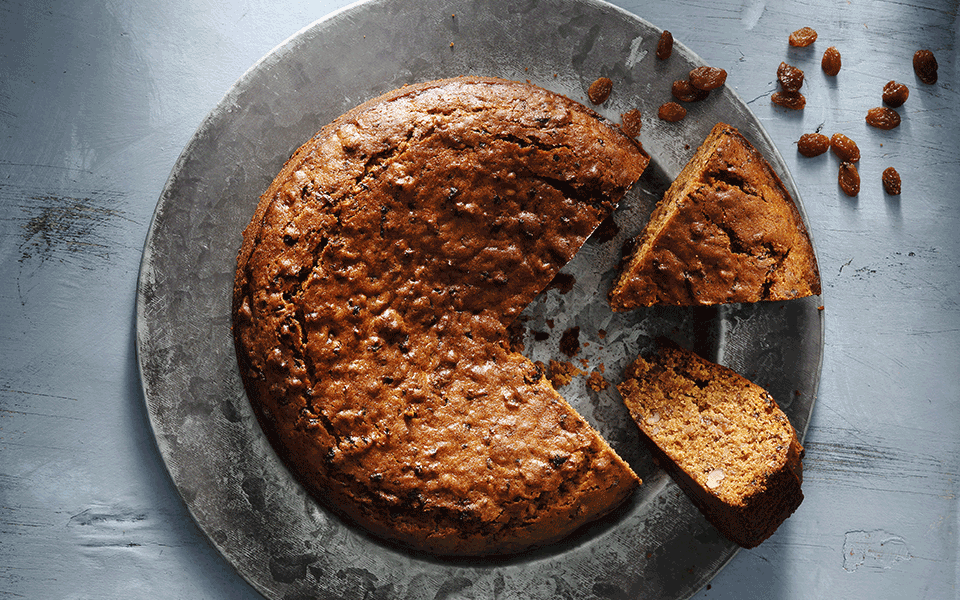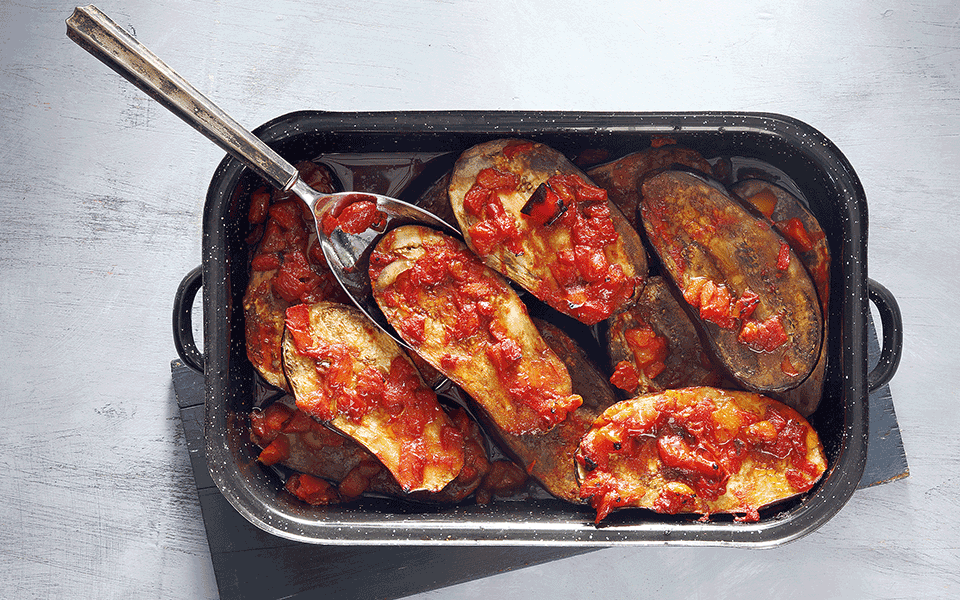Feta, Tsipouro, Sausage… and Off We Go to...
Three traditional products serve as both...

Barbounia Beans with leeks from western Crete.
© Food styling: Tina Webb, Photo: George Drakopoulos
Long before the term ‘vegan’ was coined, Greeks developed delicious dishes with no animal products thanks largely to the strict fasting rules observed during certain periods in the Orthodox church. Whether you’re a committed vegan or just looking to make the odd meat and dairy-free meal, the dishes below will leave you full and happy.
Pulses are a central feature of the country’s meals, regardless of location, and this baked bean dish is replicated in various versions from Crete to Macedonia.
Pink and white barbounia (or borlotti) beans are sold fresh in their wrinkled pods in summer in both Greek and Italian farmers’ markets. The Italians like to put them in minestrones, whereas the Greeks put them in salads or bake them, as in this recipe. They get their Greek name “barbounia” from the term for red mullet fish because their color is so similar. Disappointingly, their delightful candy-cane patterns fade in cooking, but their nutty taste still rates as superior.
Method
If you’re using giant beans (gigantes), soak them overnight before boiling. Borlotti beans need no soaking; just boil in plenty of salted water for about 20 minutes or until almost tender. Drain in a colander and place them in a large shallow baking dish.
For giant beans, bring them to a boil in a large pot of water, discard that water, and with new, salted water, bring them to the boil again and cook for about 1.5 hours. Drain and place in baking dish.
Preheat the oven to 190ºC. Sauté the leeks in the oil for about 5 minutes. Add the peppers, celery and parsley and sauté for another 2-3 minutes before adding the tomatoes. Season with salt, pepper and oregano, pour the mixture over the beans, toss and bake for about 30 minutes until a light crust forms on top and the beans are tender and juicy.

Cretan raisin cake.
© Food styling: Tina Webb, Photo: George Drakopoulos
This cake, which I make every Christmas (at least), was invented to perk up fasting periods, and thus contains no eggs or milk but uses extra virgin olive oil for shortening. Again, the ingredients represent what was on hand in a typical larder in eastern Crete.
This recipe was given to me by a woman lucky enough to use her own raisins when she bakes this. The cake has a toffee-like crunchiness on the outside, while the inside reminds me of old-fashioned wedding cake though moister and even more succulent.
It makes a scrumptious snack for winter afternoons and evenings. Leftovers can be turned into delicious rusks for dunking into coffee or tea. Leave the cake a day or two, cut it into neat pieces and bake them in a low oven for an hour or so until they’re hard. They will keep indefinitely.
Method
Preheat the oven to 190ºC.
Soak the raisins in the brandy for about 10 minutes and then chop them in the food processor.
Sift the flour and spices together into a bowl. In a separate, larger bowl, using an electric mixer if you have one, beat together the olive oil and sugar until creamy, and slowly add the orange juice along with the grated peel, soda water, brandy-soaked raisins and chopped walnuts. Stir in the flour, a little at a time, until you have a thick batter.
Slide it into a lightly oiled springform cake pan (24 cm in diameter) and bake for about 1 hour.

Eggplant smothered in garlic Zakynthos-style.
© Food styling: Tina Webb, Photo: George Drakopoulos
This baked dish contains nothing more than eggplant, tomatoes, a splash of vinegar and plenty of garlic, and yet it is one of the very best I’ve ever tasted. Furthermore, like so many dishes cooked with olive oil, it’s even better the next day.
Method
Sprinkle the eggplant slices with salt and leave them in a colander for at least 40 minutes to shed some of their liquid. Rinse and dry the slices well. Heat about an inch (2.5cm) of olive oil in a frying pan and gently fry the eggplant slices on both sides in batches. Drain on paper towels.
In another saucepan, simmer the tomatoes with salt, pepper and sugar until a thickish sauce forms. Stir in the vinegar or wine. Arrange the eggplant slices in layers in an ovenproof dish, sprinkling chopped garlic and some of the tomato sauce between each layer. Pour the remaining tomato sauce over the eggplant and bake in an oven preheated to 190°C for 30 minutes. Leave in the oven to cool and serve several hours later or the next day.
This goes well with fresh sourdough bread, feta and plenty of wine.
*From Diana Farr Louis’ books “Feasting and Fasting in Crete” and “Prospero’s Kitchen” (co-author June Marinos). Diana Farr Louis is a travel writer and expert in Greek cuisine. Her guidebooks and cookbooks dedicated to Greece are available here.
Three traditional products serve as both...
Athens sizzles with culinary creativity, blending...
Discover five of Athens’ latest openings,...
A hidden gem in Pangrati where...